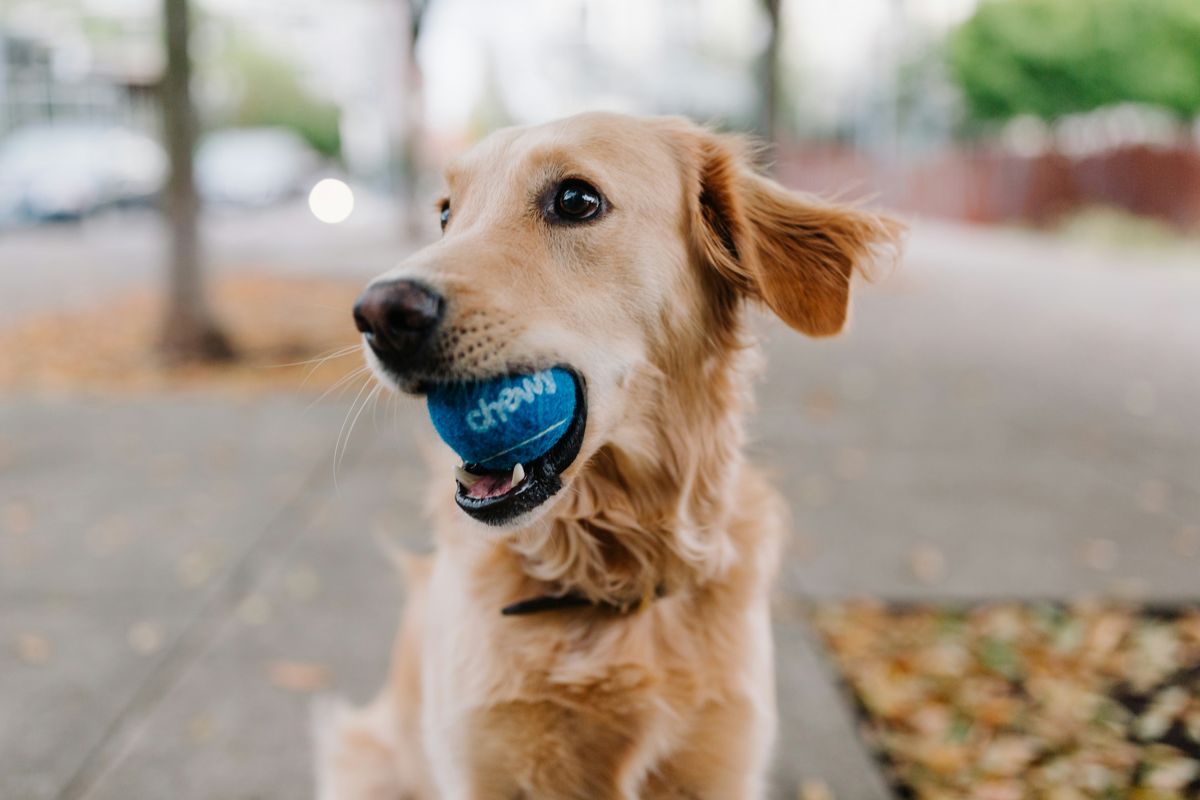The Labrador, or Labrador Retriever, is one of the most popular and beloved dog breeds in the world. Known for their gentle nature and exceptional intelligence, Labradors are ideal companion dogs for families, athletes, and people seeking an affectionate pet.
This versatile dog is also employed as a guide dog, search dog, or for rescue activities. Let’s explore the origins, physical characteristics, behavior, health, training, and many other aspects of this exceptional breed.
Origins of the Labrador #
The Labrador Retriever originates from Canada, specifically from the island of Newfoundland. Descended from the St. John’s water dogs, this breed was used by fishermen to retrieve fishing nets and bring back fish. Its work instinct, physical strength, and waterproof coat allowed it to brave the icy waters of the North Atlantic.
It was in the 19th century that the Labrador was introduced to the United Kingdom, where English breeders developed the breed as we know it today. Due to its versatility, pleasant temperament, hunting flair and swimming ability, the Labrador Retriever quickly became a household favorite and became one of the most sought-after dogs in the world.
Physical characteristics of the Labrador #
Labradors are athletic and robust dogs, with a harmonious and well-proportioned physique. They are easily recognizable by their dense coat and thick tail, which give them an appearance of power and gentleness at the same time.
Size and weight #
The Labrador Retriever is a medium to large-sized dog with a well-developed musculature. The size and weight difference between males and females is generally slight but noticeable:
| Gender | Height (inches) | Weight (pounds) |
|---|---|---|
| Male | 22-24 | 64-79 |
| Female | 21-23 | 55-70 |
Coat color #
The Labrador has a short, dense, and water-resistant coat, inherited from its marine ancestors. The coat can present three main colors:
- Black: Classic and elegant, black is a color frequently associated with this breed.
- Yellow: Ranging from pale cream to fox red, this color offers a wide variety of appearances.
- Chocolate: Rarer, the chocolate coat is sought after for its rich and warm hue.

Specificities #
The Labrador is an excellent swimmer and loves it! It is distinguished by a few physical traits that align with its passion for water. Its thick “otter tail,” covered with short and dense hair, serves as a rudder when swimming. The Labrador also has webbed feet, which enhance its swimming abilities.
Its broad muzzle and expressive eyes testify to its gentle and friendly character.
Behavior of the Labrador #
Naturally sociable, the Labrador Retriever is renowned for its patience and playful nature. Its intelligence and desire to please make it a relatively easy dog to train and integrate into a household.
Behavior with children #
The Labrador is often considered one of the best companions for families with children. Its gentle and tolerant temperament allows it to adapt to the sometimes rough play of the youngest. Always ready to interact and play, it creates a strong bond with children while showing kindness and patience.
Behavior with other animals #
In general, Labradors get along well with other animals. Thanks to their friendly nature, they coexist easily with other dogs and can even get along with cats, especially if they have been socialized from a young age. Early socialization is recommended to ensure harmonious cohabitation with all species.
Health of the Labrador #
As with all breeds, the Labrador Retriever has certain predispositions to hereditary diseases. Regular veterinary check-ups and a balanced diet are essential to maintain good health and prolong its lifespan.
Lifespan #
The average lifespan of a Labrador is between 10 and 12 years. However, some Labradors can live longer, especially if they benefit from a healthy lifestyle, a suitable diet, and enough exercise.
Common diseases #
Labradors are predisposed to certain conditions, mainly due to their genetics and morphology. Here is a summary table of the most common diseases in this breed:
| Disease | Description | Probability |
|---|---|---|
| Hip dysplasia | Abnormality of the hip joint, causing pain and lameness. | High |
| Obesity | Excess weight caused by inappropriate diet and/or lack of exercise. | High |
| Elbow dysplasia | Elbow joint problem, leading to stiffness and lameness. | Medium |
| Ear infections | Ear infections due to the drooping and closed shape of its ears. | Medium |
| Cruciate ligament rupture | Knee joint condition, often related to overweight. | Medium |
| Eye problems | Includes cataracts and progressive retinal atrophy. | Low |
It is essential to monitor the Labrador’s diet and physical activity to prevent obesity and other joint problems.
Heart and respiratory rates of the Labrador #
Thanks to the many Labradors equipped with Minitailz, we have recorded the following figures in healthy dogs:
| Median heart rate | Median respiratory rate |
|---|---|
| 58 BPM 50% of them have a rate between 54.4 and 63.7 BPM |
14.8 RPM 50% of them have a rate between 13.2 and 17.3 RPM |
Training the Labrador #
Training the Labrador is essential to channel its energy and allow it to integrate harmoniously into family life. This breed is known for its great intelligence and desire to please, making it a particularly receptive student.
However, training should start from a young age to prevent the development of undesirable behaviors. Here are some tips and methods for properly training your Labrador.
✔️ Positive training methods #
The Labrador responds very well to training methods based on positive reinforcement. Due to its affectionate nature and food motivation, it learns quickly when rewarded for good behavior. Positive methods consist of:
- Using treats as rewards to reinforce good actions.
- Praising and petting the dog for each desired behavior, thus strengthening the bond of trust.
- Avoiding punishments that can create anxiety and alter the relationship with the owner.
Training sessions should be short (5 to 10 minutes), fun, and regular. Repetition and patience are key for your Labrador to assimilate commands and desired behaviors.

✔️ Importance of early socialization #
Socialization is a crucial aspect of Labrador training. Good socialization from childhood helps prevent the emergence of undesirable behaviors in adulthood and ensures that the dog is comfortable in all situations. Early socialization consists of:
- Introducing the puppy to different people, animals, and environments.
- Gradually exposing it to various noises, such as traffic or the vacuum cleaner, for example.
- Organizing meetings with other dogs to develop its social skills.
By familiarizing your Labrador with various situations, it will become a balanced and confident adult.
✔️ House training #
House training the Labrador Retriever can be quick if started as soon as the puppy arrives home. Here are some tips to facilitate this training:
- Establish a routine: Take the puppy out at key times (upon waking, after meals, after play) to get it used to relieving itself outside.
- Choose a specific spot: Always take the puppy to the same place so it associates this space with its needs.
- Reward immediately after it relieves itself outside, reinforcing this behavior.
By being consistent and patient, the Labrador will quickly learn to be clean.
✔️ Teaching basic commands #
Teaching basic commands is essential for having an obedient and well-integrated dog in the family. Labradors are intelligent and willing dogs, capable of mastering several commands. Here are some essential commands to teach them:
- “Sit”: To teach it to control itself in various situations.
- “Down”: Useful for moments of calm and rest.
- “Heel”: To ensure a pleasant and safe walk on a leash.
- “Stay”: Essential to avoid dangerous situations, such as crossing the road.
Training should be gradual, reinforcing each command with rewards and encouragement. The regularity of sessions is important for the dog to correctly assimilate the commands.
Undesirable behaviors and how to manage them #
Yes, although the Labrador Retriever is known for its friendly and balanced character, some undesirable behaviors can manifest, especially if it has not been properly trained or does not receive enough exercise and mental stimulation.
-
Excessive chewing: Labradors love to chew, especially when they are young. This behavior can sometimes be problematic when they attack furniture, shoes, or other personal items. Chewing can be linked to boredom, teething in puppies, or stress.
- How to manage: Robust chew toys specially designed for dogs, not leaving fragile items within reach, rewarding when it chews its toys, sufficient exercise.
-
Pulling on the leash: Labradors are often very enthusiastic when they go out, which can lead them to pull on the leash. This behavior is particularly common in young Labradors, who have not yet learned to walk calmly.
- How to manage: Suitable leash and anti-pull harness, learning to walk on a leash, stopping and changing direction when it pulls.
-
Jumping on people: Labradors are often very sociable and like to show their enthusiasm by jumping on people. This behavior can be harmless, but it can also be problematic, especially with children or the elderly.
- How to manage: Ignoring when it jumps, rewarding when it keeps all four paws on the ground.
-
Begging for food: The Labrador Retriever is naturally greedy, and it is not uncommon to see it begging for food during meals.
- How to manage: Not giving food at the table, training it to stay in its place during meals.
Examples of training exercises #
The Labrador Retriever needs to be physically and mentally stimulated to avoid boredom and destructive behaviors. Here are some exercises that combine education and entertainment:
- Fetching objects: A game of fetch stimulates its natural hunting instinct and improves its obedience.
- Hide and seek: Hide treats in the house or garden and ask it to find them. This stimulates its sense of smell and keeps it active.
- Agility course: Ideal for channeling its energy and strengthening the bond with its owner, while working on its coordination.
By incorporating varied and fun exercises into its routine, you will keep your Labrador motivated and obedient.
Character and lifestyle of the Labrador #
The Labrador Retriever is a rather calm dog, but it can quickly become excited if it does not get its daily dose of exercise, or in the presence of other people and animals.
Physical activity and exercise #
The Labrador Retriever has a high energy level and needs regular physical activity. A daily walk of at least one hour, play sessions or agility and, ideally, swimming are recommended to satisfy its exercise needs.
Indoor character #
Indoors, the Labrador can be calm and affectionate, provided it has been able to expend enough energy. Without exercise, it can become destructive out of boredom. It is a dog that loves to stay close to its family and will often be “clingy”.

A very demanding dog #
Loyal and sociable, the Labrador is known for adapting to all household members. It loves company and does not tolerate prolonged solitude well. Its friendly nature also makes it appreciated by other animals.
Living environment #
Although the Labrador can live in an apartment, it is preferable that it has access to an outdoor space to expend energy. A house with a garden, a nearby park, or regular outings are essential for its balance.
Grooming and hygiene of the Labrador Retriever #
Brushing and coat care #
The Labrador’s coat should be brushed once or twice a week to remove dead hair and keep its skin healthy. During shedding periods, daily brushing may be necessary.
Ear hygiene #
Labradors have drooping ears that can be prone to infections. Weekly cleaning with a suitable solution is recommended to prevent ear infections.
Diet #
The Labrador’s diet should be balanced and adapted to its age, size, and activity level. It is important to monitor its weight, as this breed is prone to obesity. Opt for kibble rich in proteins and essential nutrients.
Adoption and cost of the Labrador #
Adoption price #
The cost of adopting a Labrador Retriever varies depending on several factors, including the dog’s origin, lineage, and place of adoption. In a professional breeding, the price of a Labrador puppy can range between 800€ and 1,500€. Puppies from working or show lines may be more expensive due to their pedigree.
In shelters, costs are generally lower, mainly covering veterinary expenses (vaccination, sterilization, identification).
Annual cost of the Labrador #
Beyond the adoption cost, it is necessary to know the costs that living with a Labrador Retriever can incur:
- Veterinary care: This includes vaccinations, anti-parasitic treatments, annual health check-ups, and possible interventions. Generally, it costs between 200€ and 500€ per year. You can also add the 150€ to 400€ needed for castration or sterilization.
- Pet health insurance: Depending on your prevention needs, you may consider taking insurance for your dog. For this, depending on the chosen plan, you will need to add about 200€ to 600€.
- Food: Costs are estimated between 400€ and 800€ per year, depending on the quality of the food. These costs may increase if you put your Labrador on a special diet, especially in case of obesity.
- Accessories: This includes bedding, leashes, collars, toys, and other necessary items, costing between 100€ and 200€ per year. Of course, it is not necessary to change all accessories every year, but consider it every 2 to 3 years.

The Labrador Retriever is an exceptional dog, both loyal, intelligent, and versatile. Its affectionate behavior and ability to learn make it an ideal companion for families, athletes, and people looking for a devoted pet. However, this breed requires special attention in terms of exercise, training, and health. By adopting a Labrador Retriever, you commit to providing it with a balanced and fulfilling life, both physically and emotionally!

